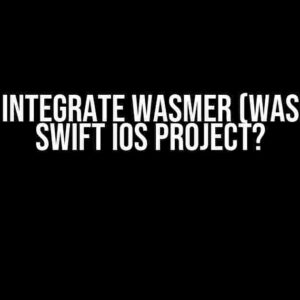Are you tired of relying on Cocoapods to integrate the MLKit library into your iOS project? Do you want to take control of your project’s dependencies and optimize its performance? Look no further! In this comprehensive guide, we’ll show you how to integrate the MLKit library without using Cocoapods, step by step.
Why Integrate MLKit Without Cocoapods?
Before we dive into the integration process, let’s discuss the benefits of not using Cocoapods:
- Faster Build Times**: By manually integrating the MLKit library, you can reduce your project’s build times, making your development process more efficient.
- Better Dependency Management**: You’ll have complete control over the versions and dependencies of the MLKit library, ensuring that your project remains stable and up-to-date.
- Increased Security**: By not relying on Cocoapods, you can reduce the risk of dependency vulnerabilities and ensure that your project’s security is not compromised.
Prerequisites
Before you begin, make sure you have the following:
- Xcode 11 or later
- iOS 11 or later
- The MLKit library (downloaded from the Google Developers website)
Step 1: Add the MLKit Framework to Your Project
Download the MLKit framework from the Google Developers website and extract the contents of the zip file. You should see the following folders:
MLKit-iOS
|- Frameworks
|- MLKitCore.framework
|- MLKitFaceDetection.framework
|- ...
|- Headers
|- MLKit.h
|- ...
Drag and drop the Frameworks folder into your Xcode project, making sure to select “Copy items if needed” and “Create groups” options.
Step 2: Add the MLKit Framework to Your Targets
Open the target settings of your project and add the MLKit framework to the “Embedded Binaries” section:
Targets
|- Your App
|- General
|- Embedded Binaries
|- MLKitCore.framework
|- MLKitFaceDetection.framework
|- ...
Step 3: Import the MLKit Framework
In your Swift file, import the MLKit framework:
import MLKit
Step 4: Initialize the MLKit SDK
In your app delegate, initialize the MLKit SDK using the following code:
import UIKit
import MLKit
@UIApplicationMain
class AppDelegate: UIResponder, UIApplicationDelegate {
func application(_ application: UIApplication, didFinishLaunchingWithOptions launchOptions: [UIApplication.LaunchOptionsKey: Any]?) -> Bool {
MLKit.configure()
return true
}
}
Step 5: Use MLKit in Your App
Now that the MLKit library is integrated, you can use its features in your app. For example, to detect faces in an image, use the following code:
import UIKit
import MLKit
class FaceDetectionViewController: UIViewController {
let faceDetector = FaceDetector(faceDetectorOptions: FaceDetectorOptions())
override func viewDidLoad() {
super.viewDidLoad()
let image = UIImage(named: "image.jpg")!
let visionImage = VisionImage(image: image)
visionImage.orientation = .up
faceDetector.process(visionImage) { [weak self] features, error in
if let error = error {
print("Error: \(error.localizedDescription)")
return
}
// Process the detected faces
for face in features!.faces {
print("Face detected at \(face.frame.origin.x), \(face.frame.origin.y)")
}
}
}
}
Troubleshooting Common Issues
If you encounter any issues during the integration process, check the following:
| Error | Solution |
|---|---|
| Failed to compile the MLKit framework | Check that the framework is correctly added to your project and that the target settings are correct. |
| MLKit framework not found | Verify that the framework is correctly linked to your project and that the framework search paths are correct. |
| SDK initialization failed | Check that the MLKit SDK is correctly initialized in your app delegate. |
Conclusion
Integrating the MLKit library without using Cocoapods might seem daunting, but with these step-by-step instructions, you can easily add the power of machine learning to your iOS app. By following this guide, you’ll be able to take advantage of the MLKit library’s features, improve your app’s performance, and optimize its dependencies.
Remember to explore the MLKit documentation and API references for more information on how to use the library’s features and optimize your app’s performance.
Get Started Today!
Start integrating the MLKit library into your iOS project today and unlock the full potential of machine learning for your app. If you have any questions or need further assistance, feel free to ask in the comments below.
Frequently Asked Question
Want to tap into the power of ML Kit without relying on CocoaPods? You’re in luck! We’ve got the lowdown on how to integrate MLKit library without using cocoapods.
Q1: What are the steps to integrate MLKit library manually?
To integrate MLKit library manually, you’ll need to download the MLKit framework from the Firebase website, add it to your project, and then import the necessary modules in your Swift file. You can find the detailed steps in the official Firebase documentation.
Q2: Do I need to add any additional frameworks or libraries?
Yes, you’ll need to add the FirebaseCore framework to your project, as it’s a dependency of MLKit. Additionally, you might need to add other frameworks depending on the specific MLKit features you want to use, such as the Vision framework for image labeling or the Natural Language framework for text analysis.
Q3: How do I import the MLKit modules in my Swift file?
To import the MLKit modules, simply add the following line to the top of your Swift file: `import FirebaseMLKit` or `import FirebaseMLKitVision` for vision-related features, and so on. Make sure to import the correct module based on the MLKit feature you’re using.
Q4: Will I need to add any additional configuration to my project?
Yes, you’ll need to enable the MLKit API in your Firebase project and configure the MLKit settings in your Info.plist file. You can find the detailed instructions in the official Firebase documentation.
Q5: Are there any potential issues I should be aware of when integrating MLKit manually?
One potential issue to watch out for is version conflicts between the MLKit framework and other frameworks in your project. Make sure to use compatible versions and test your app thoroughly to avoid any unexpected behavior.



